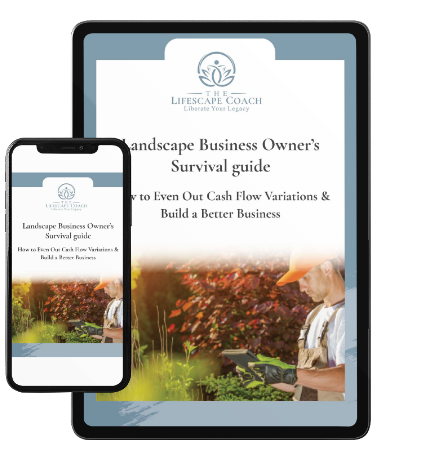How to avoid losing money over bad landscape project estimates
Virtually every small landscape business owner has experienced this situation at least once: You’re quoting a big job that you don’t want to lose, so you throw out a fast, barebones estimate that you hope will win you the business. Unfortunately, it does.
Wait….what? Unfortunately?!
Yes, because that job, instead of being the big money-maker you thought it would be, turned into a sinkhole that drained any profit out of it. Why? Because you failed to include ALL of the costs associated with delivering that project in the proposal and it came back to bite you.
All of your expenses are NOT at the job site.
Most trade professionals know about direct costs for a project – all of the materials and labor needed to successfully complete it. What they often miss in their estimates are the indirect costs, such as sales and design meetings that take up time and end up costing money in un-billed hours or the purchasing time to find, order and deliver all the materials to the job.
For example, say you’re building a patio for a client. Do you need to meet them at the supply house to pick out stone? Will you have to bring several samples to the client site for selection? At times a project will require multiple suppliers, purchases, pickups and deliveries just to get one area completed. All of this takes time and uses trucks, fuel, and other resources – more costs. That’s why it’s so important to think carefully about all the steps involved in any given project and the time and resources it takes to complete all those steps.
But wait, there’s more.
Even more elusive are overhead costs that must be factored into every proposal. These are all the boring and mundane things that are required to run a business – the costs associated with simply having employees. Things such as administrative labor, liability and health insurance, facility costs, marketing, payroll expenses, and taxes. All of these items must be added together and accounted for on every single job so that each project contributes to covering the costs of running your business. Think of overhead as if it were another employee and you have to pay them.
Factor in the unforeseen.
It’s also easy to overlook the unforeseen obstacles that can trip up a project – sick employees, subcontractors who need to be replaced mid-project, unexpected ledge that requires additional services to remove it. All of these things can and do pop up on a regular basis and need to be addressed in your proposals, such as including a project contingency clause that speaks to the potential for additional funding that may be needed to cover unforeseen issues.
And let’s not forget mobilization, set-up, and clean-up time. This is what the client sees as your crew readies the job site, brings in materials and equipment, and then cleans up after everything’s done. Adequate time has to be allowed for performing these important steps because they can set the stage for future projects and referrals. Leaving the work site pristine and impress the client with your efficiency, thoughtfulness, and thoroughness.
Break the back-of-the-envelope habit
Relying on back-of-the-envelope estimating is a sure way to hinder growth and minimize profitability. If you are guilty of this practice, you need to stop it if you want to successfully grow your business.
Be honest – does the idea of including every little time-and-material item in your proposal make you nervous? Do you think it will balloon costs way out of whack and will have a negative impact on your business? Well, I want you to banish that thought.
 Remember this – clients hire you because they are unable or unwilling to do the hard work involved in successfully creating and completing a landscape project. That makes your time, talent, and experience highly valuable and desirable to prospects. Reasonable people (and that’s who you want as clients) understand that there are costs involved in any project and if you provide a complete, professional estimate and proposal, chances are good they’ll not only understand it, they’ll accept it. So don’t sell against yourself by undercutting your own price and margin targets.
Remember this – clients hire you because they are unable or unwilling to do the hard work involved in successfully creating and completing a landscape project. That makes your time, talent, and experience highly valuable and desirable to prospects. Reasonable people (and that’s who you want as clients) understand that there are costs involved in any project and if you provide a complete, professional estimate and proposal, chances are good they’ll not only understand it, they’ll accept it. So don’t sell against yourself by undercutting your own price and margin targets.
The truth is, I too have been guilty of back-of-the-envelope estimating and been burned by that. Fortunately, I saw the warning signs and felt the pain early on and transitioned. I built an Excel spreadsheet where I listed direct cost, indirect cost, and overhead, so when I estimated it would force me to consider every item and not overlook anything. Then I got brave, and decided I would demand (kindly) an open and transparent conversations about project investments with my clients. Not easy, but the payoff is profitability, which is why you are in business!
As you grow into selling more jobs and doing more estimating, there are a number of good landscape estimating software tools you can consider. I presently use QuickBooks (estimates feature) and also Manage360, and am presently working on transitioning to LMN. We are in flux. It’s part of growing a business to the next level. When you move from 5, to 6 and then to 7-figures, you’ll find that the tools necessary for accurate and timely estimating are more and more important to your ability to guaranty profits for your business. If you’re starting out with estimating, there are helpful resource books available, such as “Landscape Estimating Methods,” which is in its fifth edition.
Regardless of what estimating tools you end up using, the point is you need some sort of system in place to help you maintain good estimating practices. Part of that system will always be focused time to pull all the data together and time to step back from it and back to it to review. By producing consistent, thorough, and accurate proposals for every project, you’ll quickly move from just covering costs to actually making money that makes a difference in your company and in your life!
Image Copyright: 123RF Stock PhotoLandscape Business Owners Survival Guide




